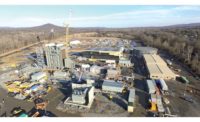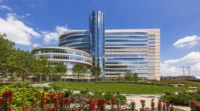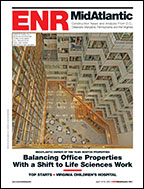A strong multifamily residential sector has been a hallmark of construction in the MidAtlantic region. Two major rail transit projects near the District of Columbia—one in Virginia, the other in Maryland—could give the sector a further lift and help it avoid the downturn that prognosticators have anticipated since the end of the last recession.
Construction is proceeding on the second phase of the Metrorail Silver Line. The $2.8-billion segment, from Reston, Va., to Dulles International Airport and on to Loudoun County, will have six stations and is scheduled to be completed in 2020.
Maryland’s Purple Line, a 16-mile light-rail project, has yet to begin construction. But it cleared a key hurdle in July when a judge issued an emergency stay that could pave the way for construction, even while lawsuits against the project continue. Construction cost is estimated at $2 billion.
The two projects are creating rail transit stations in areas that lacked them, and people who live in apartments tend to prefer being close to transit lines, says Leon Blondin, chief operating officer in Balfour Beatty’s MidAtlantic office. That spin-off effect has “created opportunity to build and create those mixed-use developments close to mass transit,” Blondin notes. “It’s just going to continue to fuel the fire a little bit.”
For example, Balfour Beatty is building Vy, a 386-unit project at Reston Heights near the Silver Line. The first phase of the $80-million job is scheduled to be delivered this fall; the remainder will be completed next year.
In Maryland, several multifamily developments are in the works along the Purple Line, a 21-station, east-west route between New Carrollton and Bethesda. One example is Gilbane Development Co.’s 463,000-sq-ft, 430-unit project in College Park, where a Purple Line station is planned near an existing Metrorail station. The development includes 12,000 sq ft of retail space. Construction reportedly will begin in 2018.
The multifamily market’s continued health is apparent in ENR MidAtlantic’s Top Contractor survey. The 67 participating firms reported $3.1 billion worth of multifamily work. Balfour Beatty, which ranked No. 16 on the list with $444.65 million in regional revenue, is building 2,000 residential units in the D.C. area.
“We certainly thought by this time frame we’d see a reduced ‘ask’ of us in terms of residential,” Blondin says. “But most of the calls coming in are from clients and developers looking for residential products out into 2018 and ’19.”
ENR Mid-Atlantic 2017 Top Contractors
Public vs. Private
The survey, which includes firms from Delaware, Maryland, Pennsylvania, Virginia, West Virginia and the District of Columbia, shows contractors performed well across public and private sectors. Based on 2016 revenue, the $22 billion in work performed and billed by this year’s contractors is more than double the $10.33 billion that the 55 participating firms reported last year.
Of the $22-billion total, approximately $15 billion came from the private sector and more than $6 billion was public-sector work. The survey’s No. 1-ranked firm, Whiting-Turner, with $2.45 billion in revenue, also ranked first in the private-sector category, with $1.9 billion. Clark, the second-ranked firm on the overall list, at $2.39 billion, was No. 1 in the public sector, with $611.38 million.
Balancing public and private work catapulted Hensel Phelps to No. 10 on the list with $630.5 million in revenue; last year it ranked No. 24 with $268.6 million.
Brian Skipper, the company’s business development manager, credits the increase to stability in the market, late procurements that shifted to 2016 from 2015 and “significantly increasing revenue in the private sector.” He notes that Hensel Phelps’ regional business mix moved to 46% public sector and 54% private sector in 2016, from 81% public, 19% private in 2015,
Two notably active sectors in the region are sewerage-solid waste and water supply. Eighteen firms on this year’s list performed sewerage-solid waste work totaling a combined $492.63 million in revenue. A total of 13 firms reported a combined $350 million in water supply work.
With $204.37 million in revenue, No. 28 PC Construction Co. ranked first in both segments. Brian Walker, who runs PC’s water and wastewater sector, says the market’s strength is based on the region’s growing population and the need to upgrade facilities to meet federal clean water regulations.
In addition to completing a $215-million tunnel-dewatering pump station contract for DC Water’s Blue Plains Tunnel this year, PC is general contractor for the $130-million Trap Rock Water Treatment Facility in Leesburg, Va. The 20-million-gallon-per-day facility includes a 400-ft-long tunnel with two 50-ft drop shafts.
PC is also working on the Hopewell Regional Wastewater Treatment Facility Phase 2 nitrogen removal improvements in Hopewell, Va. The $71.6-million, design-build project, a joint venture with HDR, aims to reduce nitrogen in the plant’s discharge to meet permit limitations for total nitrogen loading and ammonia concentrations. PC also recently won contracts to upgrade Lynchburg, Va.’s wastewater treatment plant.
Looking ahead, Walker sees bright prospects in the water-sewer segment and sees many such projects in the planning stage in the MidAtlantic region. He says the sector is “going to keep going strong based off pent-up demand.”








Post a comment to this article
Report Abusive Comment